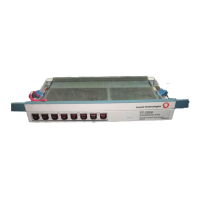Maintenance Description
9-42 Issue 8.0 July 2002
— Failures that cause hardware resets to transmitters, receivers, and
low-speed interfaces if they are the second failure within the ring.
This also includes shelf power failures, removing circuit packs, and
reinserting circuit packs.
■ Protected State: Most single failures are span failures and cause the
system to enter the protected state. In this state, 2-fiber ring protection
switching restores all service traffic. Single failures (other than node
failures) never cause service outages.
■ Potential Loss of Service State #1: If a node has a power loss (Failure A
in Figure 9-10), the system enters this state. In this state, only add/drop
traffic at the node where the power loss occurs is lost. All other traffic in the
ring is protected using 2-fiber ring protection switching. (For this reason,
this state is labeled as a potential loss of traffic.) When power is restored,
the node transitions automatically to the "Normal Operation State."
■ Potential Loss of Service State #2: If two spans fail (Failures B and C in
Figure 9-10), the system enters this state. In this state, the ring is
segmented and any loss of traffic will be from paths between the two
segments, if any existed. Like the "Potential Loss of Service State #1," the
degree of service outage depends on how traffic is provisioned (routed) on
the ring. When either of the two span failures is cleared, the system
transitions automatically to the "Protected State."
■ Potential Loss of Service State #3: If a node has a power loss and a
single span failure (Failures A and B in Figure 9-10), the system enters this
state. In this state, the ring is segmented and any loss of traffic will be from
paths between the two segments, if any existed. Any add/drop traffic at the
node where the power loss occurs is also lost. The degree of traffic loss
depends on how traffic is provisioned (routed) on the ring. In some cases,
traffic loss could be nonexistent.
■ Potential Loss of Service State #4: A node enters this state when power
is restored from the "Potential Loss of Service State #3", or from the
"Protected State (Vulnerable to Outage)." In this state, the node "wakes up"
into an incomplete ring due to the span failure. Since the ring is incomplete,
some traffic, which might be thought to be restored, will not be restored
until the span failure is cleared.
■ Protected State (Vulnerable to Outage): In this state, service is fully
protected following the reset of either OHCTL circuit pack (for any reason).
However, any hardware reset of transmitters, receivers, or east-facing
low-speed interfaces will cause the system to enter the "Potential Loss of
Service State #4."
■ Partial Repair State: In Release 5 and later releases, a node can enter
this state with some manual intervention. In releases prior to Release 5,
partial repair is not possible. In this state, some additional traffic can be
restored before the span failure is cleared. When the span failure clears,
the node can enter the "Normal Operation State" with some manual

